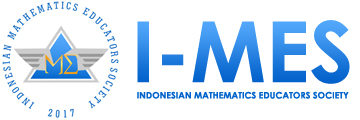Ethnomathematics in the Meto Tribe Tradition of Corn Binding
Abstract
Keywords
Full Text:
PDFReferences
Alangui, W. V. (2010). Stone walls and water flows: Interrogating cultural practice and mathematics. Doctoral Dissertation. Auckland: University of Auckland.
Arisetyawan, A., Suryadi, D., Herman, T., Rahmat, C., & No, J. D. S. (2014). Study of Ethnomathematics: A lesson from the Baduy Culture. International Journal of Education and Research. Citeseer. Retrieved from http://citeseerx.ist.psu.edu/viewdoc/download?doi=10.1.1.1046.6613&rep=rep1& type=pdf
Arnidha, Y. (2018). Analisis Pemahaman Konsep Matematika Siswa Sekolah Dasar Dalam Penyelesaian Bangun Datar. JPGMI, 3(1), 53–61. https://ojs.stitmultazam.ac.id/index.php/JPGMI/ article/view/22.
Bassanezi, R. C. (2002). Ensino-aprendizagem com modelagem matemática [Teaching and learning with mathematical modeling]. São Paulo, SP: Editora Contexto.
Bishop, A. J. (1988). Mathematics education in its cultural context. Educational Studies in Mathematics, 19(2), 179-191. https://doi.org/10.1007/BF00751231
Cai, J., Cirillo, M., Pelesko, J. A., Borromeo Ferri, R., Borba, M., Geiger, V., Stillman, G., English, L. D., Wake, G., Kaiser, G., & Kwon, O. N. (2014). Mathematical modeling in school education: Mathematical, cognitive, curricular, instructional and teacher education perspectives. In Proceedings of the 38th Meeting of the International Group for the Pyschology of Mathematics Education (pp. 145–172).
Creswell, John W. (2011). Educational Rresearch:Planing, Conducting, and Evaluating Quantitative and Qualitative Research. Boston: Pearson.
D’Ambrosio, U. (1993). Etnomatemática: Um programa [Ethomathematics: A program]. A Educação Matemática em Revista, 1(1), 5–11.
D’Ambrosio, U. (2016). An overview of the history of Ethnomathematics. In M. Rosa, U. D’Ambrosio, D. C. Orey, L. Shirley, W. V. Alangui, P. Palhares, & M. E. Gavarrete (Ed.). Current and Future Perspectives of Ethnomathematics as A Program (pp. 5- 10). Cham: Springer. https://doi.org/10.1007/978-3-319-30120-4_2
D'Ambrosio, U. (1985). Ethnomathematics and its place in the history and pedagogy of mathematics. For the learning of Mathematics, 5(1), 44-48.
de Loiola Araújo, J. (2010). Brazilian research on modelling in mathematics education. ZDM, 42(3-4), 337-348. https://doi.org/10.1007/s11858-010- 0238-9
Fajarini, U. (2014). Peranan kearifan lokal dalam pendidikan karakter. Sosio-Ddidaktika: Social Science Education Journal, 1(2), 123–130. https://doi.org/10.15408/sd.v1i2.1225
Fouze, A. Q., & Amit, M. (2017). On the importance of an ethnomathematical curriculum in mathematics education. EURASIA Journal of Mathematics, Science and Technology Education, 14(2), 561-567. https://doi.org/10.12973/ejmste/76956
Gulo, W. (2000). Metodologi Penelitian. Jakarta: Grasindo.
Heuvel-Panhuizen, M. V. D. (2003). The didactical use of models in realistic mathematics education: An example from a longitudinal trajectory on percentage. Educational Studies in Mathematics, 54(1), 9–35. Retrieved from http://link.springer.com/article/10.1023/B:EDUC.0000005212.03219.dc
Ikeda, T. (2013). Pedagogical reflections on the role of modelling in mathematics instruction. In Teaching Mathematical Modelling: Connecting to Research and Practice (pp. 255-275). Springer. https://doi.org/10.1007/978-94-007-6540-5_22
Ismajli, H., & Imami-Morina, I. (2018). Differentiated instruction: Understanding and applying interactive strategies to meet the needs of all the students. International Journal of Instruction, 11(3), 207-218. https://doi.org/10.12973/iji.2018.11315a.
Kaminski, E. (2004). Turning Points in Qualitative Research: Tying Knots in a Handkerchief. Contemporary Sociology: A Journal of Reviews, 33(6), 738–739. https://doi.org/10.1177/009430610403300669
Karnilah, N. (2013). Study Ethnomathematics : Pengungkapan Sistem Bilangan Masyarakat Adat Baduy. Universitas Pendidikan Indonesia, Bandung., 44(8), 821–822. https://respository.upi.edu/id/exprint/385
Koentjaraningrat. (2009). Pengantar Ilmu Antropologi. Jakarta: Rineka Cipta.
Lesh, R., Galbraith, P. L., Haines, C. R., & Hurford, A. (2010). Modeling students’ mathematical modeling competencies: ICTMA 13. Modeling Students’ Mathematical Modeling Competencies: ICTMA 13 (pp. 1–651). Springer US. https://doi.org/10.1007/978-1-4419-0561-1
Matang, R. (2002). The role of ethnomathematics in mathematics education in Papua New Guinea: Implications for mathematics curriculum. Journal of Educational Studies, 24(1), 27-37.
Muhtadi, D., Sukirwan, S., Warsito, W., & Prahmana, R. C. I. (2017). Sundanese Ethnomathematics: mathematical activities in estimating, measuring, and making patterns. Journal on Mathematics Education, 8(2), 185-198. https://doi.org/10.22342/jme.8.2.4055.185-198
Munawaroh, H. (2017). Pengembangan Model Pembelajaran dengan Permainan Tradisional Engklek Sebagai Sarana Stimulasi Perkembangan Anak Usia Dini. Jurnal Obsesi : Jurnal Pendidikan Anak Usia Dini, 1(2), 86. https://doi.org/10.31004/obsesi.v1i2.19
Nurjanah, N., Mardia, I., & Turmudi, T. (2021). Ethnomathematics study of Minangkabau tribe: formulation of mathematical representation in the Marosok traditional trading. Ethnography and Education, 16(4), 437–456. https://doi.org/10.1080/17457823.2021.1952636
Prabawati, M. N. (2016). Etnomatematika Masyarakat Pengrajin Anyaman Rajapolah Kabupaten Tasikmalaya. Infinity Journal, 5(1), 25. https://doi.org/10.22460/infinity.v5i1.p25-31
Prihastari, E. B. (2015). Pemanfaatan Etnomatematika Melalui Permainan Engklek Sebagai Sumber Belajar. Jurnal Kajian Pendidikan Dan Pengajaran, 1(2), 155–162. Retrieved from http://jm.ejournal.id/index.php/mendidik/article/view/23/13
Risdiyanti, I., & Prahmana, R. C. I. (2020a). Ethnomathematics (Teori dan Implementasinya: Suatu Pengantar). Yogyakarta: UAD Press.
Risdiyanti, I., Prahmana, R. C. I., & Shahrill, M. (2019). The learning trajectory of social arithmetic using an Indonesian traditional game. Elementary Education Online, 18(4), 2094–2108. https://doi.org/10.17051/ilkonline.2019.639439
Rosa, M., & Orey, D. C. (2003). Vinho e queijo: etnomatemática e modelagem!. Bolema-Boletim de Educação Matemática, 16(20), 1-16.
Rosa, M., & Orey, D. C. (2010). Ethnomodeling as a pedagogical tool for the ethnomathematics program. Revista Latinoamericana de Etnomatemática Perspectivas Socioculturales de la Educación Matemática 3(2),14–23.
Rosa, M., & Orey, D. C. (2016). State of the art in Ethnomathematics. In M. Rosa, U. D’Ambrosio, D. C. Orey, L. Shirley, W. V. Alangui, P. Palhares, & M. E. Gavarrete (Ed.). Current and Future Perspectives of Ethnomathematics as A Program (pp. 11- 37). Cham: Springer. https://doi.org/10.1007/978-3-319-30120-4_3
Shirley, L., & Palhares, P. (2016). Ethnomathematics and its Diverse Pedagogical Approaches. In Current and Future Perspectives of Ethnomathematics as a Program (pp. 13–17). Springer.
Sowanto, & Mulyadin, E. (2019). Developing of teaching materials for junior high school students based on ethnomathematics on traditional woven cloth (Tembe Nggoli) of Mbojo tribe. In Journal of Physics: Conference Series (Vol. 1280). Institute of Physics Publishing. https://doi.org/10.1088/1742-6596/1280/4/042044
Spradley. J. P. (2007). Metode Etnografi. Yogyakarta: Tiara Wacana.
Sutarto, S., Hastuti, I. D., & Supiyati, S. (2021). Etnomatematika: Eksplorasi Transformasi Geometri Tenun Suku Sasak Sukarara. Jurnal Elemen, 7(2), 324–335. https://doi.org/10.29408/jel.v7i2.3251
Refbacks
- There are currently no refbacks.

This work is licensed under a Creative Commons Attribution-NonCommercial-ShareAlike 4.0 International License.
Indonesian Journal of Ethnomathematics
Indonesian Mathematics Educators Society
Jl. Terusan Jend. Sudirman, Kec. Cimahi Tengah, Kota Cimahi, Jawa Barat 40521
E-mail: [email protected]
ISSN: 2775-8001


